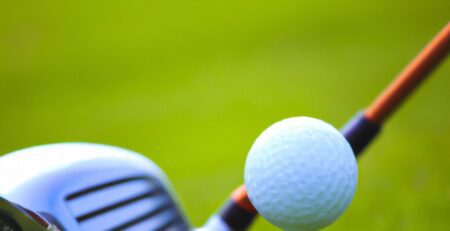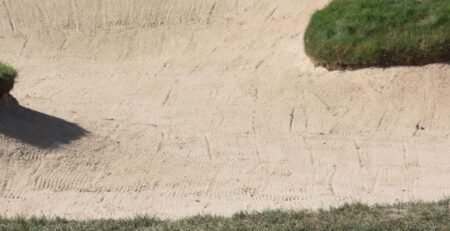4 Top Golf Chipping Tips for all Golf Players
Golf chipping is critical for a golfer’s short game, as it can make or break their overall score. To help your chipping skills, there are various tips and techniques ranging from grip, stance, swing mechanics, to club selection and mental preparation. For any level of golfer, improving your technique in these areas can help you to achieve up and downs with greater success. In this article we will be discussing some of the highly effective golf chipping tips that can raise your game and aid in becoming a better player.

Use a shorter backswing. This will help you to have more control over the club.
Using a shorter backswing when chipping can be an effective way to increase control over the club. A shorter backswing limits the amount of movement and speed generated by the club, which can help you to be more precise and accurate with your shots.
Here are some tips for using a shorter backswing when chipping:
- Keep your arms and hands close to your body. This will help you to minimize the amount of movement in your swing and keep it more compact.
- Take the club back to a point where your wrists cock naturally. This will help you to create a shorter backswing that is comfortable and easy to repeat.
- Focus on making a smooth, controlled swing. This will help you to maintain your accuracy and consistency.
- Keep your head still and your eyes focused on the ball. This will help you to make a smooth stroke and improve accuracy.
- Practice chipping with a shorter backswing. This will help you to get a feel for the movement and develop muscle memory.
- You might not always have to keep a shorter backswing on all your chips, but it’s a good idea to practice it to have it as an option. Sometimes, depending on the shot, you might need to use a longer backswing to generate more power or distance. The key is to practice and find the right balance that suits your swing and the situation you are in.
Keep your hands ahead of the clubhead. This will help you to hit the ball first and then the ground.
- Keeping your hands ahead of the clubhead is an important aspect of chipping technique. It helps to ensure that the clubface strikes the ball before it makes contact with the ground, which is crucial for producing a clean, crisp chip shot.
- Make sure your hands are ahead of the clubhead at address. This means that the clubhead should be slightly behind your hands when you set up to the ball.
- Keep your hands ahead of the clubhead throughout the entire swing. This will help you to hit the ball first and then the ground.
- Use your wrists to control the clubhead. This will help you to keep your hands ahead of the clubhead and generate a descending blow on the ball.
- Try to make a descending blow on the ball. This will help you to hit the ball first and then the ground.
- Practice chipping with your hands ahead of the clubhead. This will help you to develop muscle memory and make it easier to replicate the feeling during a round.
Keeping your hands ahead of the clubhead is not only about your downswing but also about your setup and your backswing, so you should be aware of this concept throughout your entire swing. It’s an essential technique that allows you to hit the ball with a descending blow and create backspin on the ball, which is essential for controlling the ball’s flight and distance.
Use your wrists to generate power. This will help you to hit the ball with more speed.
Using your wrists to generate power when chipping can help you to hit the ball with more speed and distance. The wrists are a key source of power in the golf swing, and by utilizing them correctly, you can add extra speed and distance to your chip shots.

- Make sure your wrists are in a good position at address. This means that they should be cocked, with your left wrist (for right-handed golfers) slightly bowed, and your right wrist slightly cupped.
- Use a slight wrist hinge on the backswing. This will help you to cock your wrists and store energy in them.
- Use your wrists to release the stored energy on the downswing. This will help you to generate power and hit the ball with more speed.
- Practice using your wrists to generate power. This will help you to develop muscle memory and make it easier to replicate the feeling during a round.
- Get Professional help from D&A Golf, who understand how to use your wrists correctly and generate more power in your chip shots.
Using your wrists to generate power is not just about the downswing, but it starts from the setup and the backswing. You need to have a good wrist position at address and use a slight wrist hinge on the backswing to store energy in your wrists, and then use it to generate power on the downswing. Also, it’s important to find the right balance between power and control, as too much power can cause loss of accuracy, so it’s important to practice and find the right balance that suits your swing and the situation you are in.

Practice chipping with different clubs. This will help you to find the club that works best for you and the different situations you may encounter on the course.
Practicing chipping with different clubs can help you to find the club that works best for you and the different situations you may encounter on the course. Different clubs have different characteristics and can be used to hit different types of chip shots, so it’s important to try out different options and find the one that feels most comfortable and effective for you.
- Try out different types of wedges. This includes pitching wedges, gap wedges, sand wedges, and lob wedges. Each type of wedge has a different loft and bounce, and it’s worth trying them out to see which one works best for you.
- Experiment with different shaft lengths. Some golfers prefer a shorter shaft for more control, while others prefer a longer shaft for more power.
- Try out different types of clubheads. This includes blade-style and mallet-style clubheads. Each type has its own unique characteristics, and it’s worth trying them out to see which one feels the most comfortable for you.
- Test different clubs on the course. The best way to know how a club performs is by using it on the course. Try different clubs on the course and see how they perform under different conditions.
- Take professional help. A golf pro or a club fitter can help you to find the right club for you by analysing your chipping stroke and recommending clubs that will work best for you.
With a variety of clubs to choose from when chipping, you to adapt to different situations on the course. For example, using a pitching wedge can help you to hit a chip shot with more speed and distance, while using a lob wedge can help you to hit a high, soft shot that stops quickly on the green. Also, as you develop your skills and gain experience, you will be able to make better decisions on which club to use in different situations.
Conclusion
In conclusion, golf putting and chipping are important aspects of the game that can make a big difference in your score. By following the tips discussed in this article, you can improve your skills and become more consistent on the green. It’s important to remember that golf is a game of practice and repetition, so it’s essential to spend time on the practice green and course to hone your skills and find the right techniques that work for you. Additionally, taking lessons with D&A Golf can also be beneficial to further improve your skills. With the right mindset, practice and techniques, you will be able to lower your scores and take your game to the next level.










